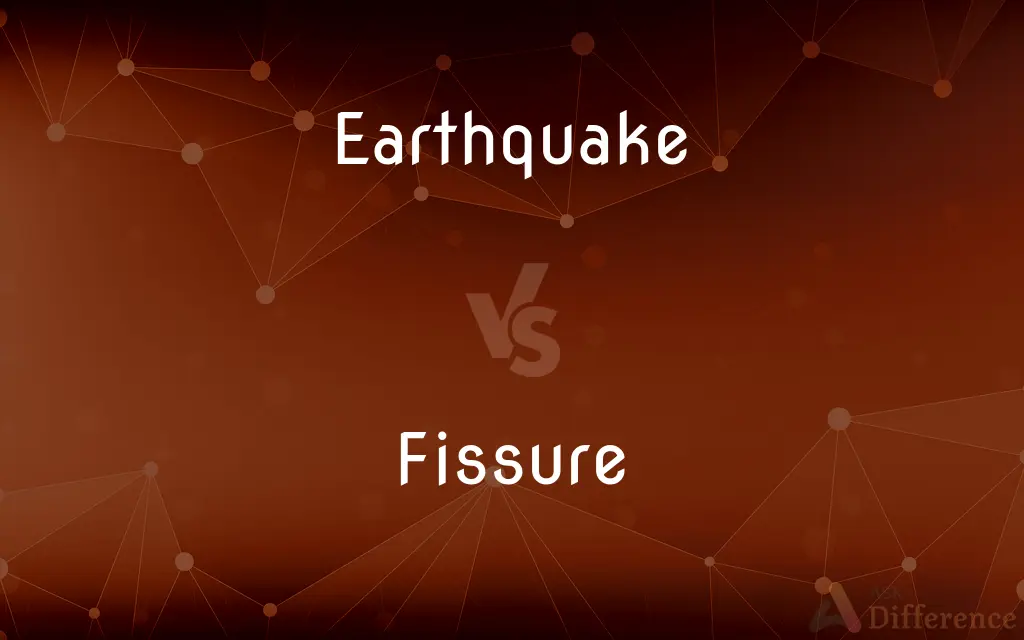Earthquake vs. Fissure — What's the Difference?
By Maham Liaqat & Fiza Rafique — Updated on April 16, 2024
Earthquakes involve sudden ground shaking caused by tectonic movements, while fissures are narrow, long cracks formed in the earth's surface.

Difference Between Earthquake and Fissure
Table of Contents
ADVERTISEMENT
Key Differences
Earthquakes are natural phenomena resulting from the sudden release of energy in the Earth's crust that creates seismic waves. Whereas fissures are openings or splits in the earth's surface, often caused by the stretching of the ground due to tectonic forces or volcanic activity.
During an earthquake, the ground shakes, sometimes violently, which can lead to structural damage, changes in the earth's surface, and even tsunamis if undersea faults are involved. On the other hand, fissures typically do not involve shaking but are directly visible as cracks which can be several meters deep and wide, often appearing in volcanic and seismic regions.
Earthquakes can occur anywhere in the world but are most common along the edges of tectonic plates where faults are prevalent. Whereas fissures are more likely to appear in specific geological settings, such as rift valleys and areas with volcanic activity.
The effects of earthquakes can be widespread, impacting larger areas depending on the magnitude and depth of the seismic event. In contrast, fissures generally affect more localized areas, although they can be quite large and disruptive, particularly in terms of altering local topography and affecting infrastructures.
Predicting earthquakes is currently beyond our scientific capabilities with precision; seismic activity can often give some short-term warnings, but accurate predictions are not possible. Meanwhile, fissures can sometimes be anticipated in volcanic areas where ground deformation measurements indicate increasing stress.
ADVERTISEMENT
Comparison Chart
Definition
Sudden ground shaking due to tectonic forces.
Long, narrow crack in the earth's surface.
Cause
Movement along faults, tectonic plate shifts.
Ground stretching, volcanic activity.
Common Locations
Along tectonic plate boundaries, fault lines.
Volcanic areas, rift zones.
Effects
Ground shaking, structural damage, tsunamis.
Ground displacement, localized damage.
Prediction
Short-term seismic activity observed, long-term unpredictable.
Sometimes predictable in volcanic regions.
Compare with Definitions
Earthquake
Measured by seismographs.
Seismologists analyzed the earthquake data recorded on the seismograph.
Fissure
Often associated with ground stretching.
The land around the rift valley is marked by numerous fissures.
Earthquake
Often occurs near tectonic plate boundaries.
California experiences earthquakes due to the San Andreas Fault.
Fissure
Can appear during volcanic eruptions.
Fissures on the volcano's slope were spewing ash and gases.
Earthquake
Can trigger tsunamis and landslides.
The 2004 tsunami was triggered by a massive undersea earthquake.
Fissure
Can be several meters deep.
The fissure was deep enough to obstruct the mountain trail.
Earthquake
A sudden and violent shaking of the ground.
The earthquake caused buildings to sway and roads to crack.
Fissure
A long, narrow opening in the earth's surface.
The volcanic activity created a fissure that emitted lava.
Earthquake
A result of underground geological forces.
The earthquake was felt across the state due to its high magnitude.
Fissure
Affects local topography.
New fissures altered the landscape of the national park.
Earthquake
An earthquake (also known as a quake, tremor or temblor) is the shaking of the surface of the Earth resulting from a sudden release of energy in the Earth's lithosphere that creates seismic waves. Earthquakes can range in size from those that are so weak that they cannot be felt to those violent enough to propel objects and people into the air, and wreak destruction across entire cities.
Fissure
In anatomy, a fissure (Latin fissura, plural fissurae) is a groove, natural division, deep furrow, elongated cleft, or tear in various parts of the body. It is also generally called a sulcus, but this term can also reffer specifically to the analagous brain structure.
Earthquake
A sudden movement of the earth's crust caused by the release of stress accumulated along geologic faults or by volcanic activity. Also called seism, temblor.
Fissure
A long narrow opening; a crack or cleft.
Earthquake
A shaking of the ground, caused by volcanic activity or movement around geologic faults.
Fissure
The process of splitting or separating; division.
Earthquake
(planetary geology) Such a quake specifically occurring on the planet Earth, as opposed to other celestial bodies.
Fissure
A separation into subgroups or factions; a schism.
Earthquake
(figuratively) A sudden and intense upheaval; a severely disruptive event.
Fissure
(Anatomy) A normal groove or furrow, as in the liver or brain, that divides an organ into lobes or parts.
Earthquake
(intransitive) To undergo an earthquake.
Fissure
(Medicine) A break in the skin, usually where it joins a mucous membrane, producing a cracklike sore or ulcer.
Earthquake
A shaking, trembling, or concussion of the earth, due to subterranean causes, often accompanied by a rumbling noise. The wave of shock sometimes traverses half a hemisphere, destroying cities and many thousand lives; - called also earthdin, earthquave, and earthshock.
Fissure
To form a crack or cleft or cause a crack or cleft in.
Earthquake
Like, or characteristic of, an earthquake; loud; startling.
The earthquake voice of victory.
Fissure
A long, narrow crack or opening made by breaking or splitting, especially in rock or earth.
Earthquake
Shaking and vibration at the surface of the earth resulting from underground movement along a fault plane of from volcanic activity
Fissure
(anatomy) A groove, deep furrow, elongated cleft or tear between body parts or in the substance of an organ; a sulcus.
Earthquake
A disturbance that is extremely disruptive;
Selling the company caused an earthquake among the employees
Fissure
(anatomy) A break or slit in tissue usually at the junction of skin and mucous membrane.
Fissure
A state of incompatibility or disagreement.
Fissure
To split, forming fissures.
Fissure
A narrow opening, made by the parting of any substance; a cleft; as, the fissure of a rock.
Fissure
To cleave; to divide; to crack or fracture.
Fissure
A long narrow depression in a surface
Fissure
A long narrow opening
Fissure
(anatomy) a long narrow slit or groove that divides an organ into lobes
Fissure
Break into fissures or fine cracks
Common Curiosities
How can earthquakes be detected?
Earthquakes are detected using seismographs, which record the intensity and duration of ground vibrations.
Are fissures dangerous?
Fissures can be dangerous if they compromise structural integrity or open suddenly in populated areas.
How do fissures form?
Fissures form due to the stretching or fracturing of the earth’s surface, often influenced by tectonic or volcanic activity.
Can earthquakes cause fissures?
Yes, strong earthquakes can lead to the formation of fissures, especially near the epicenter or along fault lines.
What is the difference in the location occurrence between earthquakes and fissures?
Earthquakes can occur nearly anywhere, while fissures are more commonly found in volcanic and rift zones.
What are the environmental impacts of fissures?
Fissures can alter landscapes, affect water drainage patterns, and create new ecological niches.
What causes an earthquake?
Earthquakes are caused by the sudden release of stress along faults in the Earth's crust.
Are there warning signs before an earthquake?
There are often minor tremors and changes in animal behavior, but no reliable short-term warning signs.
Can fissures be repaired?
Large fissures often cannot be "repaired" but can be managed through engineering solutions to mitigate hazards.
Can both earthquakes and fissures cause damage to infrastructure?
Yes, both can cause significant damage; earthquakes through shaking and fissures by ground displacement.
How do scientists measure fissures?
Scientists measure fissures using ground surveys and sometimes remote sensing techniques to determine their length, width, and displacement.
How long do fissures last?
Fissures can remain for extended periods, often becoming more pronounced with subsequent geological activity.
Do earthquakes affect all types of terrain?
Earthquakes can affect various terrains but are more destructive in areas with loose, water-saturated soils.
What is the relationship between tectonic plates and fissures?
Fissures often occur in regions where tectonic plates are pulling apart, such as in rift valleys or mid-ocean ridges.
What should you do during an earthquake?
Drop, cover, and hold on; stay indoors if inside, away from windows and exterior walls.
Share Your Discovery

Previous Comparison
Argument vs. Subject
Next Comparison
Melange vs. OlioAuthor Spotlight
Written by
Maham LiaqatCo-written by
Fiza RafiqueFiza Rafique is a skilled content writer at AskDifference.com, where she meticulously refines and enhances written pieces. Drawing from her vast editorial expertise, Fiza ensures clarity, accuracy, and precision in every article. Passionate about language, she continually seeks to elevate the quality of content for readers worldwide.














































